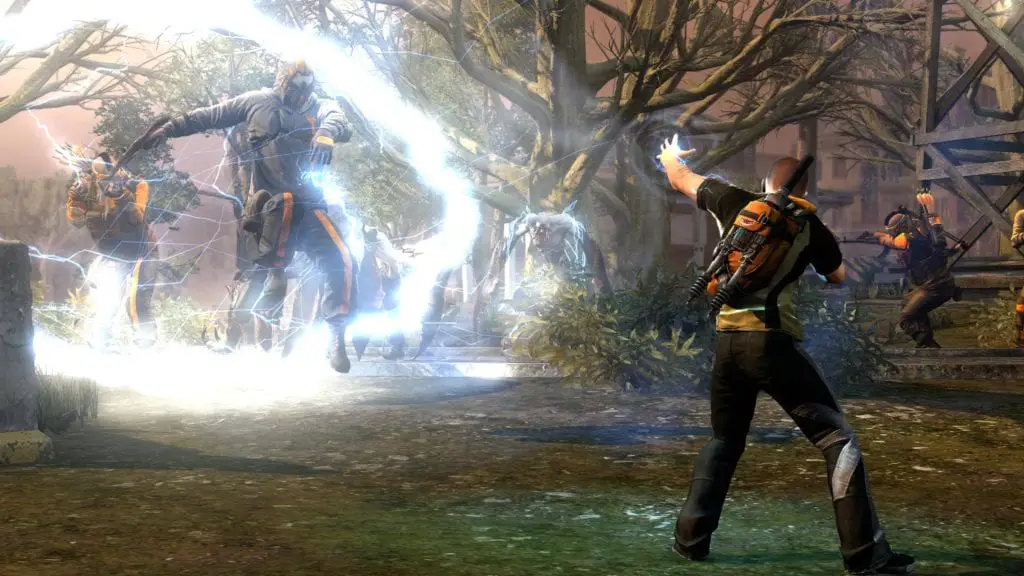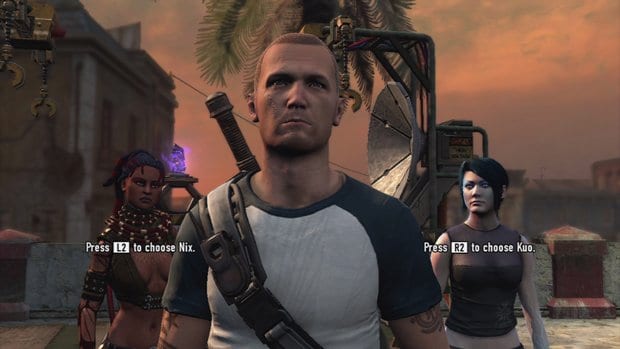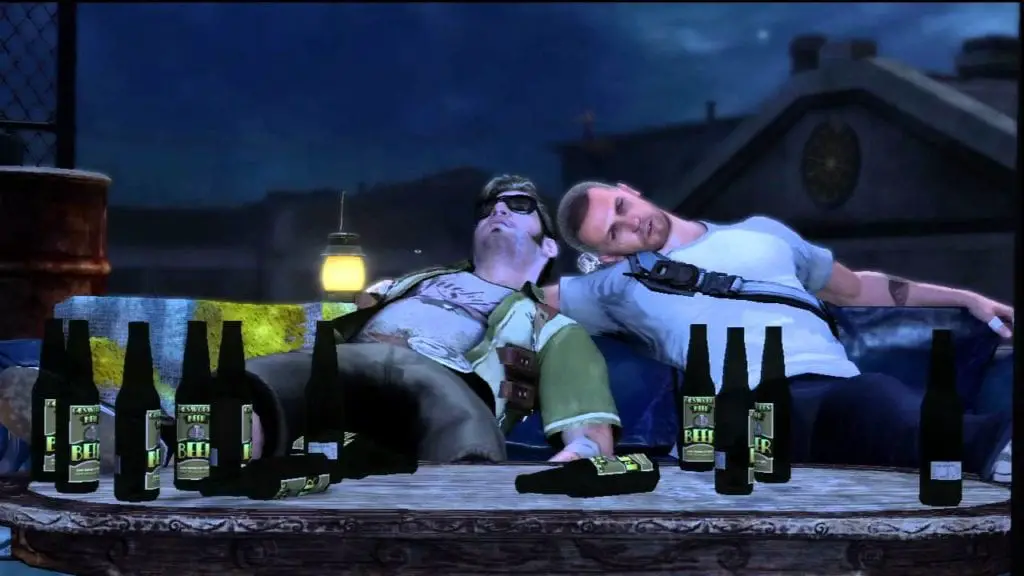Multiple endings is a story-telling device that only works in video games. No other artistic medium can present a story with multiple endings without compromising the work as a whole. Can you imagine reading a book that finishes with three wildly different chapters detailing the ultimate fate of the characters? How about a TV series whose entire final season was episode after episode featuring ending after ending?
The multiple ending has been around for a long time. It straddles numerous genres, including survival horror, RPGs, interactive dramas and occasionally even action games. The most common conceit in which the difference in endings is based around a story with moral choices. Choose to save people and you get the ‘Good Ending’; choose to murder people and you get the ‘Bad Ending’, that sort of thing.
There is nothing inherently wrong with a simplistic set-up like this. Some games attempt to avoid the simplicity by providing additional choices in situations, or obfuscating the ‘good’ path, or by simply employing decent writing. The latter is the focus of this article.
See, a frequent problem with moral choice systems is that most games are mostly linear, meaning whether or not the player character is forced by the player to do good or ill, they must still follow the same general story path (at least until the end). This can easily result in a character with wildly contrasting actions from scene to scene.
Yet the problem can be avoided if the writers think a little more than not at all. Such is the case with InFamous 2.
Electric, Man
The original InFamous, released in 2009, bares all the hallmarks of a superhero story released in close proximity to The Dark Knight. The tone is grim, the world craptastic, the colour scheme muted. This constant seriousness is entirely at odds with the central conceit; a man get electric superpowers and flies around blowing stuff up.
The sequel, released in 2011, bares all the hallmarks of a superhero story released in close proximity to the Marvel Cinematic Universe becoming the biggest franchise in recent history. Suddenly wry humour is balanced well with character driven drama, and the colour palate remembers that green, yellow and red all exist. An electric man flying around while blowing stuff up suddenly works a lot better in this context.
The bare bones of the adventure is that Cole McGrath, aforementioned electric man, fights racist militia and swamp monsters in New Marais (not New Orleans, because it would be in poor taste to blow that place up in a video game, just somewhere exactly like it). Hanging over his head is the fact that The Beast, a seemingly invincible force of nature, seems to be bent on wiping out humanity. This is a simple story.
Cole’s guiding motivation is becoming powerful enough to kill The Beast. He is helped by his schlubby best friend Zeke (a very well written character) and two female superheroes who act as dueling love interests (which, being the part where the writers screwed up, will need to be addressed later). So far, so simple.

Decisions, Decisions
As is clear by its title (and its prominence in an article about multiple endings), InFamous 2 has two endings. There is nothing subtle or difficult to discern about these two finales. One is clearly the Good Ending, the other is clearly the Bad Ending. Which ending occurs is decided by a binary choice right before the final set piece of the game.
Final binary choices is susceptible to a lot of flak from gamers who like choice based games. Life is Strange gets plenty of criticism from a section of its fandom that views its final choice as rendering all the previous choices moot (which I disagree with, but that is a topic I have covered before). The point is that InFamous 2 does not in fact give players the usual choice.
While the binary choice is presented (sacrifice yourself to save humanity, or wipe out humanity to save yourself and a few thousand others), the player is unable to choose both. The game is littered with moral choices throughout which decide whether Cole is a hero or a villain. By the time the final choice arrives, Cole is already too far down either path to turn back.
Which means heroic Cole is only permitted to choose the Good Ending, while evil Cole can only choose the Bad Ending. The game will not let the player completely contradict the established personality of the main character at the very end of the story. This is not the most elegant way of maintaining a cohesive narrative, but its simplicity is admirable.
A Digression into Sexism
I need to take a brief pit-stop from the actual point of this whole thing for a second. It is frustrating at the best of times when an otherwise well-written story has an idiotic sub-plot. It is downright maddening when that sub-plot has the only two prominent female characters be rivals for the main character’s affections. It is borderline unfathomable when said sub-plot makes the characters go beyond the realms of even faintly rational thought in the world’s dumbest moral choice.
There is a machine that transfers powers from one superhero to another. Kuo (the sensible and steady hero) has already been forced into transferring her powers to an army of lunatics. The process was hideously painful and leaves her traumatised. One would not be surprised to see her balk at the idea of using it again.
Roughly halfway through the game Cole finds the machine. He wants to use it (his whole goal being to become stronger), as does Nix (the reckless and needlessly sexualised anti-hero). So these two characters established as being immature want to risk strapping themselves into a machine they know tortured Kuo; fair enough, that very much fits their characters.
Then things suddenly goes off the rails. Kuo suddenly decides that she should be the one who uses the machine with Cole, motivated by nothing more than jealously of him sharing it with Nix. This spirals quickly into both of them declaring that Cole must choose them or they will leave him forever. Kuo even threatens that she will be forced to hunt him down like a criminal should he choose Nix (for some reason, despite Cole not breaking the law).
So now we have two woman trying to emotionally blackmail a man into letting them be the one who gets to put themselves through torture to make him more powerful. How is this something that happens in otherwise well-written game? How does this happen in a game where prejudice and inclusion are well explored themes? And why does allowing Kuo to go through torture again count as the morally good choice here?
In short, who the hell wrote this mess, and why did no one else stop them?

The Good Bad Ending
Another problem with having two binary endings is that one often feels like a fail state. Telling a player that they failed by being evil (or at least incompetent) is a tremendous way to leave them unsatisfied with the ending.
On the other hand, if the game is actually trying to make a point about morality, then the option to fail has to exist for the choice to mean anything. If there is no possibility of the hero screwing up and failing to save the day, then there is no real reason to agonise over decisions. If the story is predestined to end in triumph then there are no stakes.
InFamous 2 avoids creating a fail state by mirroring the priorities of what the player has been doing for ten hours in order to qualify for the Bad Ending. To garner the status of infamous in this game, Cole must show a total disregard for human life, a massive regard for self-preservation and an addiction to destruction.
With this in mind, the ending feels appropriate. Cole becomes the leader of horde of superheroes who travel the world murdering millions and shredding society into utter anarchy. Clearly this is a failure of morality, but it does not feel like the player has failed, but rather taken their villainous actions to the logical extreme.
Compare this ending to The Suffering, which has the quintessential fail-state of a Bad Ending. If you do bad things while trying to escape from an evil prison island, you turn into a literal monster, blow up the boat that would have brought you to freedom and inexplicably return to the prison. This is not a well-written ending. This is a game punishing you in the dumbest way possible.
Twice as Bright
As mentioned above, the other issue with binary Good and Bad Endings is the too frequent failure to actually make a point about morality, despite allegedly basing the resolution on moral choices. There has to be consequences for being evil otherwise there is little reason to avoid doing so (particularly when the evil option is usually the easier option). For a Bad Ending to stick the landing, a player cannot walk away feeling like they triumphed (which is difficult, since as I mentioned above, they cannot feel like the failed either).
While Zeke is a well-written character, this was not always the case. In the original game he was a failed attempt at comic-relief, a conspiracy nut with little purpose in the plot. There seemed no discernible reason why anyone would be friends with this man. There was certainly no reason to care about him.
The sequel rehabilitates the character by making him useful. He spies on the racist militia, he comes up with plans, and he builds useful machines. He even manages to save Cole from being killed three quarters of the way into the story. Zeke feels like a real human being and someone you could actually imagine wanting around. Zeke goes from the failed comic-relief to the heart of the story.
Then the Bad Ending makes you murder him.
Because of course it does. The premise of Cole becoming a monster is a disregard for human life. Of course that would extend to Zeke once he became an obstacle. And of course he would become an obstacle, being the moral heart of the story and thus unsurprisingly opposed to global genocide. There is no scenario where he could possibly be okay with this. Zeke has to stand in your way, and you have to kill him.
And that is the ultimate consequence of your actions. You get to have all the anarchic fun you wanted, but in the end you had to murder your best friend to keep the party going. You have morally failed and the game is not shy in explaining that to you, but neither does it pull a cheap eleventh hour unmotivated final action.
In short, the game lets you win, but it makes sure you understand the cost of your victory. That is the hallmark of a good Bad Ending.

Conclusion
Can you tell I really like InFamous 2? This is one of the few games I bought at launch, despite my predilection usually being to wait until the price drops to something slightly more affordable. I must have completed the game at least half a dozen times.
Yet I have only ever gotten the Bad Ending once. There is no desire in me to go back and do it again. Perhaps that is the best thing that can be said in the game’s favour. I will never forget the Bad Ending, but no part of me ever wants to have to murder Zeke again.
Not a lot of games do this. Not a lot of games stick the landing when it comes to making the Bad Ending feel right. For every Undertale there are a hundred games more like The Suffering or Silent Hill: Homecoming. As I have said a million times before, writing good video game narratives is no easy thing.
Which is why I am so impressed that of all the games to attempt binary moral choice driven endings, a game centered around an electric man who summons tornadoes to fight racists somehow ended up being among the more cleverly written.

